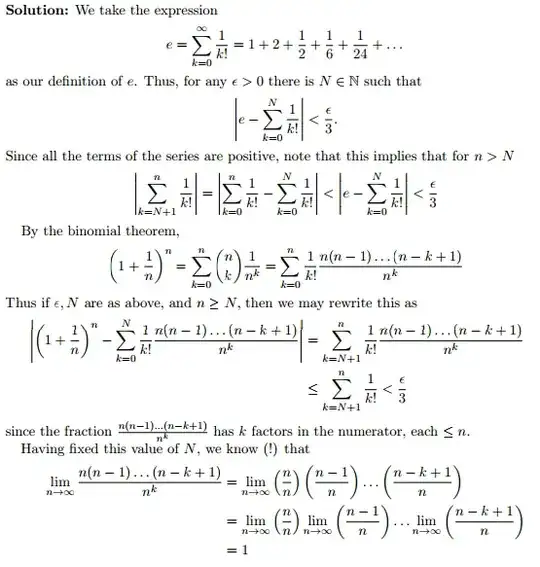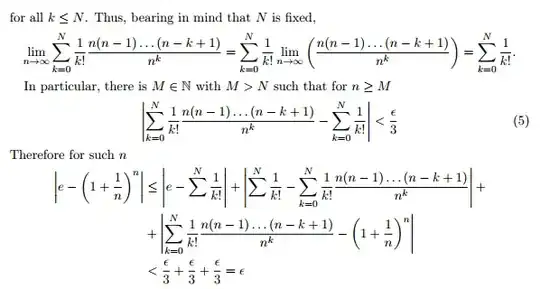One needs to establish the following two properties:
1) $\displaystyle \lim_{x \to 0}\frac{e^{x} - 1}{x} = 1$
2) $\displaystyle e^{x + y} = e^{x}\cdot e^{y}$
and it turns out that both of these can be derived (albeit with some minor difficulty) using the definition $$e^{x} = \lim_{n \to \infty}\left(1 + \frac{x}{n}\right)^{n}$$
We start with 1) first and that too with limitation $x \to 0+$. We have
$\displaystyle \begin{aligned}\lim_{x \to 0+}\frac{e^{x} - 1}{x} &= \lim_{x \to 0+}\dfrac{{\displaystyle \lim_{n \to \infty}\left(1 + \dfrac{x}{n}\right)^{n} - 1}}{x}\\
&= \lim_{x \to 0+}\lim_{n \to \infty}\frac{1}{x}\left\{\left(1 + \dfrac{x}{n}\right)^{n} - 1\right\}\\
&= \lim_{x \to 0+}\lim_{n \to \infty}\frac{1}{x}\left\{\left(1 + x + \dfrac{(1 - 1/n)}{2!}x^{2} + \dfrac{(1 - 1/n)(1 - 2/n)}{3!}x^{3} + \cdots\right) - 1\right\}\\
&= \lim_{x \to 0+}\lim_{n \to \infty}\left(1 + \dfrac{(1 - 1/n)}{2!}x + \dfrac{(1 - 1/n)(1 - 2/n)}{3!}x^{2} + \cdots\right)\\
&= \lim_{x \to 0+}\lim_{n \to \infty}(1 + \phi(x, n))\end{aligned}$
where $\phi(x, n)$ is a finite sum defined by $$\phi(x, n) = \frac{(1 - 1/n)}{2!}x + \cdots + \frac{(1 - 1/n)(1 - 2/n)\cdots(1 - (n - 1)/n)}{n!}x^{n - 1}$$ For fixed positive $x$ the function $\phi(x, n)$ is a increasing sequence bounded by the convergent series $$F(x) = \frac{x}{2!} + \frac{x^{2}}{3!} + \cdots$$ Hence the limit $\lim_{n \to \infty}\phi(x, n)$ exists and let say it is equal to $\phi(x)$. Then $0 \leq \phi(x) \leq F(x)$. Now let $x < 2$ and then we can see that $$F(x) \leq \frac{x}{2} + \frac{x^{2}}{2^{2}} + \frac{x^{3}}{2^{3}} + \cdots = \frac{x}{2 - x}$$ Hence $\lim_{x \to 0+}F(x) = 0$ and therefore $\lim_{x \to 0+}\phi(x) = 0$.
We now have
$\displaystyle \begin{aligned}\lim_{x \to 0+}\frac{e^{x} - 1}{x} &= \lim_{x \to 0+}\lim_{n \to \infty}1 + \phi(x, n)\\
&= \lim_{x \to 0+}1 + \phi(x)\\
&= 1 + 0 = 1\end{aligned}$
From this it follows that $\lim_{x \to 0+}e^{x} = 1$. To handle the case for $x \to 0-$ we need to use another trick. We show that for $x > 0$ we have $$\lim_{n \to \infty}\left(1 - \frac{x}{n}\right)^{-n} = e^{x}$$ Clearly we have
$\displaystyle \begin{aligned}\left(1 - \frac{x}{n}\right)^{-n} - \left(1 + \frac{x}{n}\right)^{n} &= \left(1 + \frac{x}{n}\right)^{n}\left\{\left(1 - \frac{x^{2}}{n^{2}}\right)^{-n} - 1\right\}\\
&< e^{x}\left\{\left(1 - \frac{x^{2}}{n}\right)^{-1} - 1\right\} = \frac{x^{2}e^{x}}{n - x^{2}}\end{aligned}$
and this last expression tends to $0$ as $n \to \infty$ and hence $$\lim_{n \to \infty}\left(1 - \frac{x}{n}\right)^{-n} = \lim_{n \to \infty}\left(1 + \frac{x}{n}\right)^{n} = e^{x}$$ Taking reciprocals we see that $$\lim_{n \to \infty}\left(1 - \frac{x}{n}\right)^{n} = \frac{1}{e^{x}}$$ or in other words $e^{-x} = 1/e^{x}$ for $x > 0$ and by duality it holds for $x < 0$ also. Thus we can see that if $x \to 0-$ then we can write $x = -y$ so that $y \to 0+$ and then
$\displaystyle \begin{aligned}\lim_{x \to 0-}\frac{e^{x} - 1}{x} &= \lim_{y \to 0+}\frac{e^{-y} - 1}{-y}\\
&= \lim_{y \to 0+}\frac{e^{y} - 1}{y}\frac{1}{e^{y}} = 1\cdot 1 = 1\end{aligned}$
Thus we have established two properties of $e^{x}$ namely $$\lim_{x \to 0}\frac{e^{x} - 1}{x} = 1,\,\, e^{-x} = \frac{1}{e^{x}}$$ The second property allows us to consider only positive arguments of the exponential function. Thus to establish the fundamental property $e^{x + y} = e^{x} \cdot e^{y}$ we need to consider $x, y > 0$ (for $x = y = 0$ it is obviously true). We can see that
$\displaystyle \begin{aligned} f(x, y, n) &= \left(1 + \frac{x}{n}\right)^{n}\left(1 + \frac{y}{n}\right)^{n} - \left(1 + \frac{x + y}{n}\right)^{n}\\
&= \left(1 + \frac{x + y}{n} + \frac{xy}{n^{2}}\right)^{n} - \left(1 + \frac{x + y}{n}\right)^{n}\\
&= \left(1 + \frac{x + y}{n}\right)^{n}\left\{\left(1 + \frac{xy}{n(n + x + y)}\right)^{n} - 1\right\}\\
&< e^{x + y}\left\{\left(1 + \frac{xy}{n^{2}}\right)^{n} - 1\right\}\\
&= e^{x + y}\left\{\frac{xy}{n} + \frac{(1 - 1/n)}{2!}\left(\frac{xy}{n}\right)^{2} + \cdots\right\}\\
&< e^{x + y}\left\{\frac{xy}{n} + \left(\frac{xy}{n}\right)^{2} + \cdots\right\}\\
&= e^{x + y}\frac{xy}{n - xy}\end{aligned}$
This shows that for fixed $x, y > 0$ the function $f(x, y, n) \to 0$ as $n \to \infty$. And therefore we have established $e^{x}e^{y} - e^{x + y} = 0$. Now we can easily show that
$\displaystyle \begin{aligned}\frac{d}{dx}e^{x} &= \lim_{h \to 0}\frac{e^{x + h} - e^{x}}{h}\\
&= \lim_{h \to 0}e^{x}\cdot\frac{e^{h} - 1}{h} = e^{x} \cdot 1 = e^{x}\end{aligned}$

